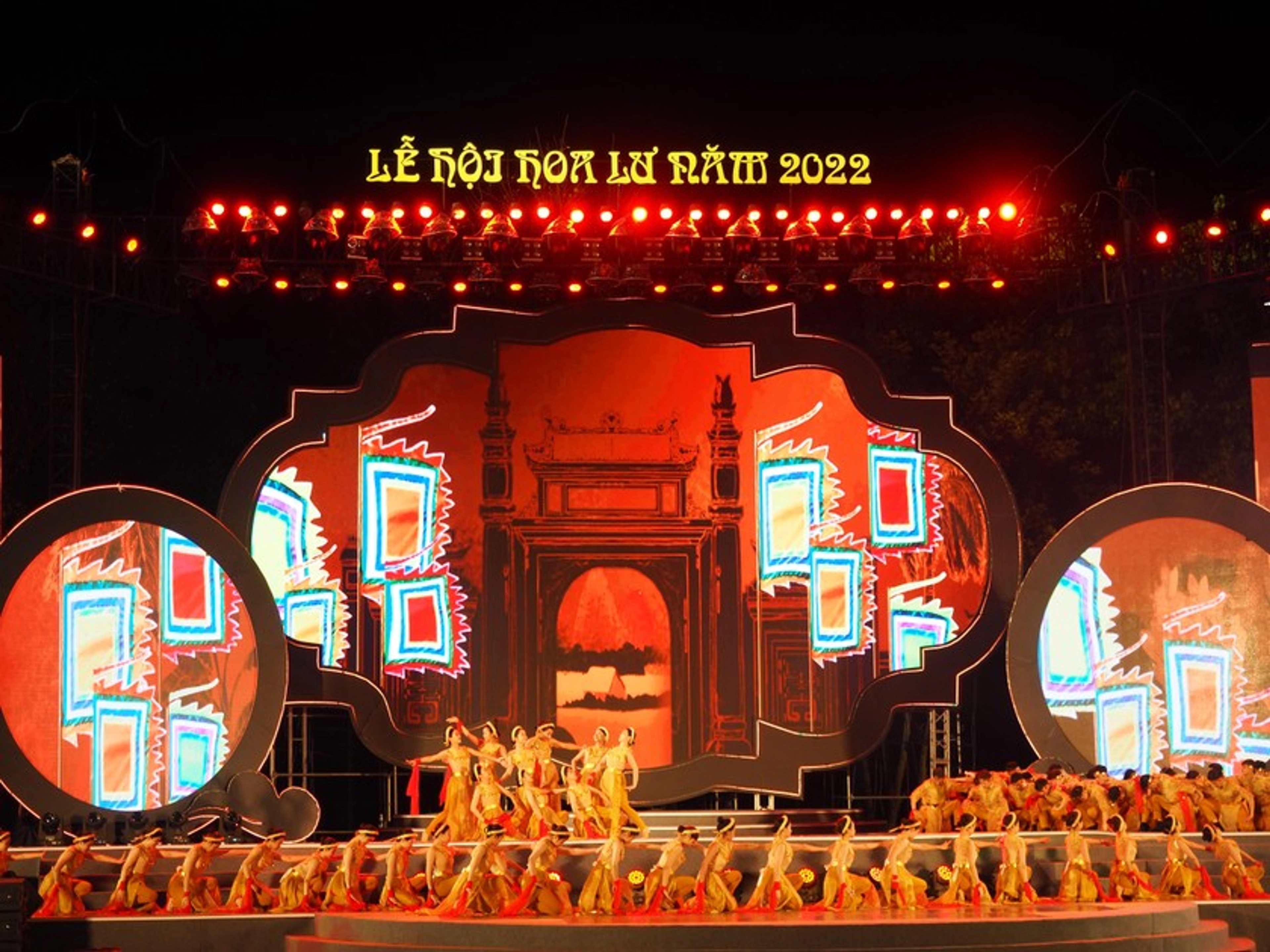

Every year, during the third lunar month, visitors from across the country flock to the ancient capital of Hoa Lu to immerse themselves in the traditional festival of this historic land. Join BDATrip to explore the exciting experiences that the Hoa Lu Festival has to offer!
The Hoa Lu Festival, also known as the Truong Yen Festival or Co Lau Festival, marks one of Vietnam's oldest cultural events. It is currently recognized as a national intangible cultural heritage and is under consideration for elevation to a national festival with state-level ceremonies.
Each year, the festival is held to commemorate and honor Dinh Bo Linh, the national hero who established the capital at Hoa Lu and founded the Dai Co Viet state, initiating a period of prolonged independence and unity for the Vietnamese through the Dinh, Le, and Ly dynasties.

The Hoa Lu Festival vividly and authentically portrays the life, contributions, and achievements of Emperor Dinh Tien Hoang to the nation's history. In the past, this event was organized with great ceremony and tradition by the feudal dynasties. Today, the festival continues to uphold its influence and glory, preserving unique aspects of folk culture and art, while aiming to be recognized as a national celebration.
Since Hoa Lu was chosen as the capital, the Hoa Lu Festival has become a significant event, considered a national celebration. Each festival occasion sees the participation of dignitaries from famous courts such as Hue and Thang Long, attending with great ceremony.
According to "Kham dinh Dai Nam hoi dien su le," an important historical document, the Nguyen dynasty annually organized grand ceremonies to worship the ancestral emperors, including four very important kings: King Dinh Tien Hoang, among others. Specifically, Emperor Minh Mang had built a temple for Emperor Dinh Tien Hoang in Duong Xuan village, within the capital of Hue, highlighting the importance and solemnity of the Hoa Lu Festival. Since then, the ritual worship of Emperor Dinh Tien Hoang has been officially conducted biannually in spring and autumn, demonstrating the court's reverence for the founder of the Dai Co Viet.
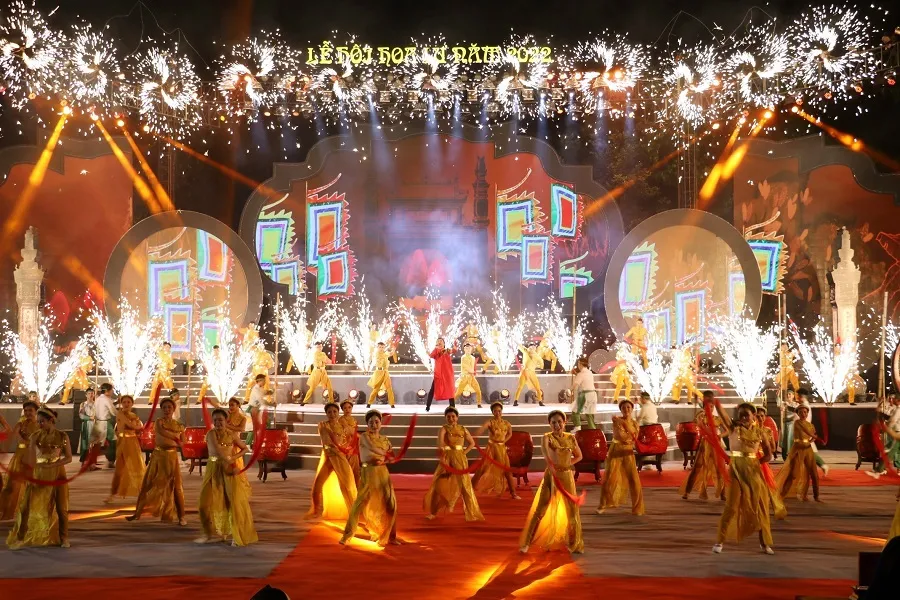
The persistence and development of the Hoa Lu Festival to this day is the result of a complex historical process, blending orthodox historical elements with folk legends.
The Hoa Lu Festival is held annually at the ancient capital of Hoa Lu in Truong Yen, Hoa Lu district, Ninh Binh province, and is a distinctive cultural event divided into two parts: the ceremonial and the festive. The ceremonial part, particularly significant, honors ancient cultural values, including traditional rites such as the Temple Opening Ceremony, the Water Procession,... Among these, the Water Procession is a standout activity, attracting thousands of participants from both local and visiting populations.
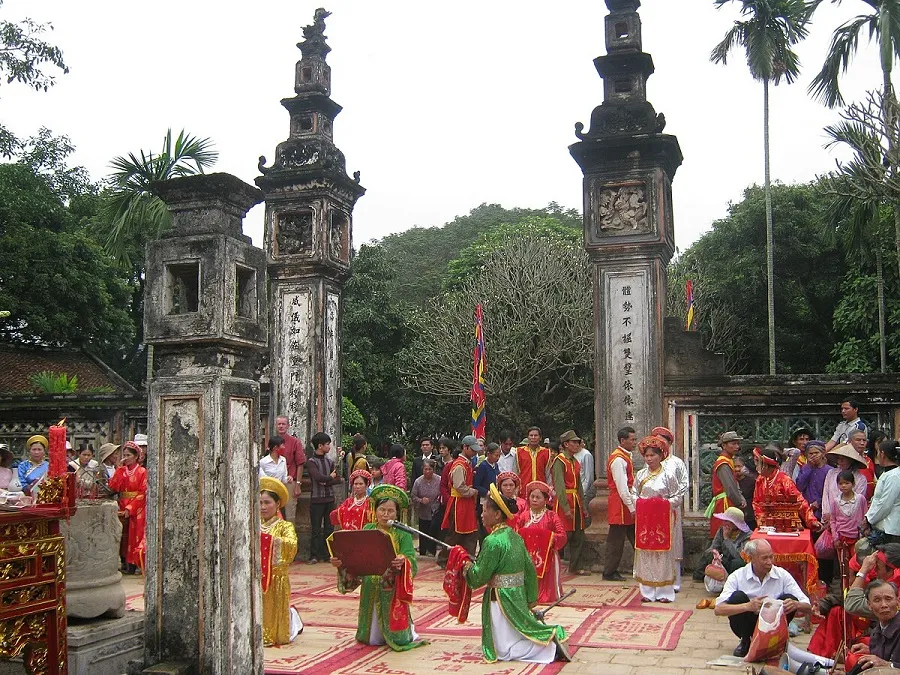
This festival is organized from the 6th to the 8th day of the third lunar month, providing a perfect opportunity to explore not just Hoa Lu but also the historic Trang An area. If you plan to travel to Ninh Binh for about 4 days and 3 nights during this period, make sure to participate in the festival to gain a deep understanding of the culture and community spirit of this area.
The Hoa Lu Festival takes place at two main temples, dedicated to King Dinh Tien Hoang and King Le Dai Hanh. It begins with the Temple Opening Ceremony held one day before the official start of the festival. After this rite, visitors are free to enter and exit the temple without the usual requirement for admission tickets, allowing everyone to fully participate and enjoy the festive atmosphere. This is an opportunity not only to admire the architectural beauty of the temples but also to immerse oneself in the solemn and respectful atmosphere of the festival.
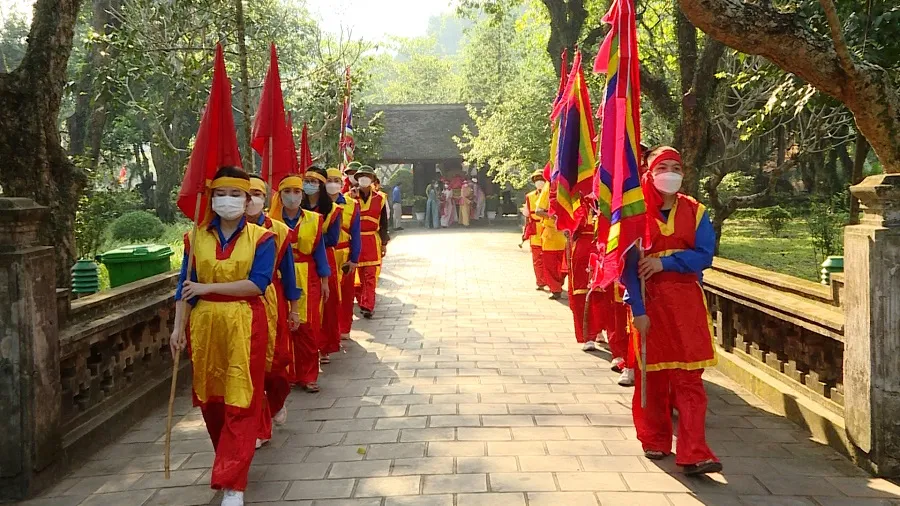
The Water Procession at the Hoa Lu Festival is a deeply meaningful ceremony held early in the morning on the 8th day of the third lunar month, marking the beginning of the festival's main day. This moment is special as the community comes together to reflect on their origins, showcasing unity and gratitude.
The ritual starts at the Temple of King Dinh Tien Hoang, where pilgrims walk to the Hoang Long River. Here, they pause to collect water, symbolizing purification and the reverence of sacred values.
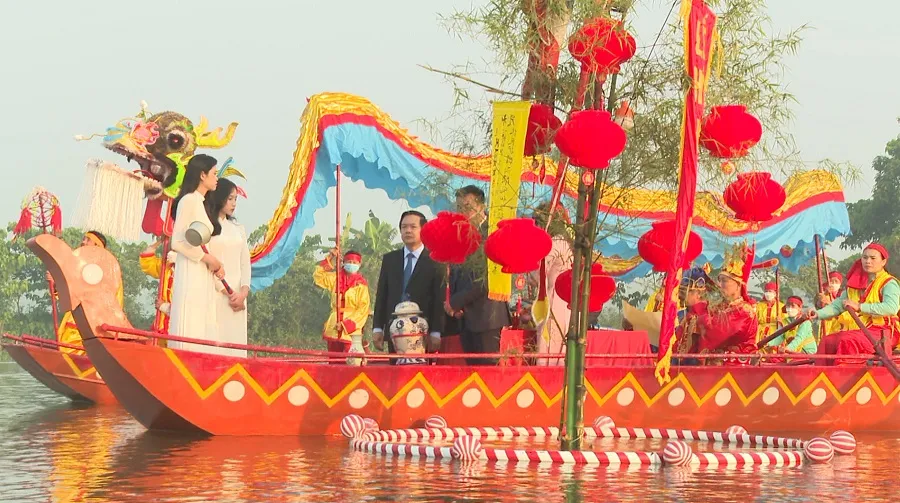
Before the festival day, a large bamboo is selected on the riverbank, and a yellow banner with inscriptions about the legendary “golden dragon” that helped Emperor Dinh is hung. This setup not only creates a solemn space but also emphasizes the value of the Vietnamese proverb “When drinking water, think of its source,” representing gratitude and respect for the ancestors who founded and protected the nation.
The Statue Bathing Ceremony, also known as the Moc Duc Ceremony, is a key part of the Hoa Lu Festival events, conducted at dawn on the day of the festival. Before proceeding, the chief ritual organizer—a senior religious official—must perform a ceremony to ask for the king's permission to commence the Moc Duc and other related rites. This not only shows reverence but also links traditional practices with the authority of the king, central to all cultural and spiritual activities in a feudal society.
The ceremony involves bathing the statue of King Dinh Tien Hoang—the founder of the Dai Co Viet state—with water from the Hoang Long River, brought during the Water Procession. The bathing not only aims for purification and prayers for peace but also serves to reenact and honor the king's distinguished contributions, reaffirming the spiritual values and respect of the people towards their forebearers.
The Fire Procession is an integral and deeply symbolic ceremony of the Hoa Lu Festival, illustrating the historical continuity from Emperor Dinh Bo Linh’s humble beginnings in his hometown to his reign as a unifying emperor of the country. This process is not just a geographical journey but a spiritual one, celebrating the great achievements he attained.
The ceremony starts at the Temple of King Dinh Bo Linh in Gia Phuong, Gia Vien district, regarded as his birthplace. There, the sacred fire is lit, symbolizing the recognition and homage to the origins and humble start of King Dinh Bo Linh. The procession then performs rituals of incense offering and earth worship, seeking permission from the deities and ancestors to carry the fire. These rites not only display respect but also pray for the nation's peace and prosperity.
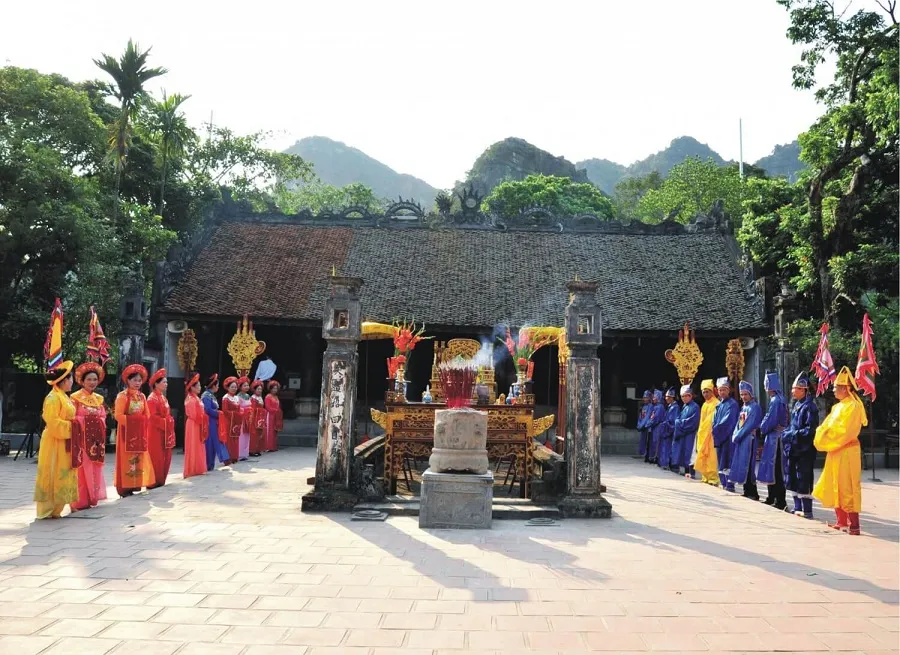
Subsequently, the procession parades along the King Dinh road, heading towards the King Dinh Tien Hoang Temple in Truong Yen, Hoa Lu district. Here, the sacred fire is used to light other fires, passing the flame from one generation to the next throughout the festival. This act not only acknowledges and honors King Dinh Tien Hoang’s contributions but also highlights the importance of preserving and promoting the cultural and historical values of the Vietnamese people.
As soon as the water procession returns to the central festival stage and completes the dragon release ritual, the main worship ceremony at the temples of Kings Dinh and Le officially begins. This part involves multiple groups that have registered in advance. These groups, including those carrying palanquins and incense from the sites honoring notable figures from the Dinh-Le period, gather at the two temples. Due to the distance, most groups use festival vehicles to travel to Hoa Lu.
The worship ceremony is held throughout the day and night at both temples, where locals and tourists can enter to light incense and pay respects. The ceremony's content includes praising the virtues and achievements of Kings Dinh Tien Hoang and Le Dai Hanh, emphasizing their crucial roles in Vietnamese history.
The opening performance of the Hoa Lu Festival is always one of the most spectacular and impressive parts, broadcast live so that people everywhere can watch. The event begins with the introduction of dignitaries and opening speeches by central and local leaders, followed by the Hoa Lu Festival drum performance.
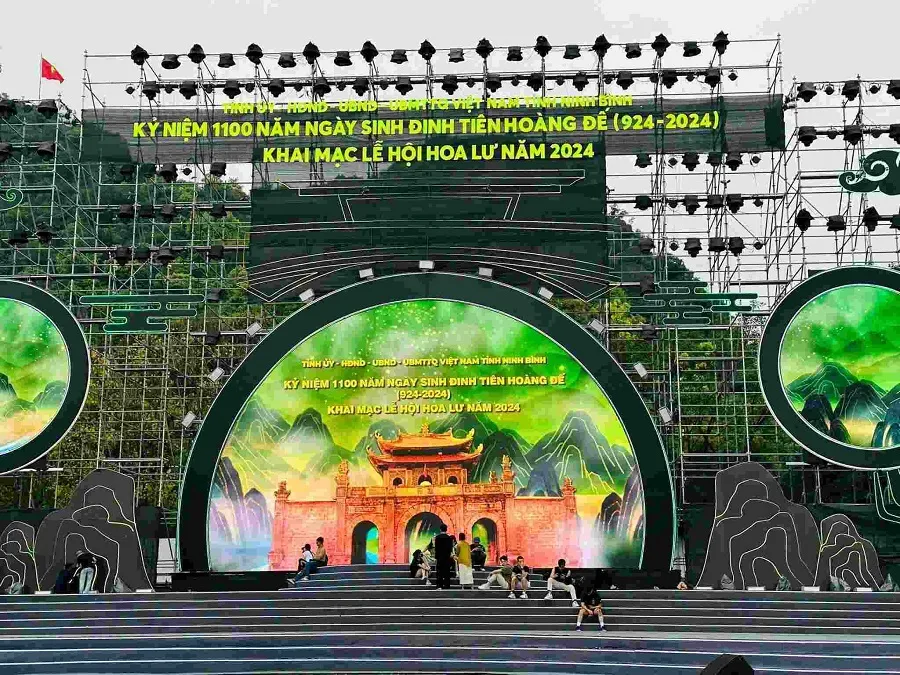
The highlight of the opening is the reenactment of significant historical events that took place in the ancient capital of Hoa Lu. Dramatic moments such as King Dinh Bo Linh's ascension to the throne, King Le Hoan's victory over the Tong invaders, and the transfer of the capital to Thang Long are vividly performed by the Ninh Binh Cheo Theater. The opening ceremony concludes with the symbolic dragon release, signifying peace and prosperity, and lasts until the end of the morning.
The "Cờ Lau Drill Performance" is a folk play integral to the Hoa Lu Festival, depicting the training and martial prowess of a young Dinh Bo Linh. This event is not only a form of entertainment but also holds educational value, portraying the national hero's talents and determination from a young age.
Sixty adolescents aged 13 to 15 participate in this performance. These youths are carefully selected, and the most noble-looking among them is honored to play the role of Dinh Bo Linh. The character wears a special costume, including a straw 'binh thien' hat and a lau flower with golden and purple petals, symbolizing the future king.
Additionally, the Thung Lau and Thung La troops, equipped with traditional musical instruments like gongs, large drums, and wooden clappers, stand on either side of the stage, singing and responding to one another. They not only provide the musical backdrop for the performance but also contribute to the heroic atmosphere as they depict a training scene of King Dinh.
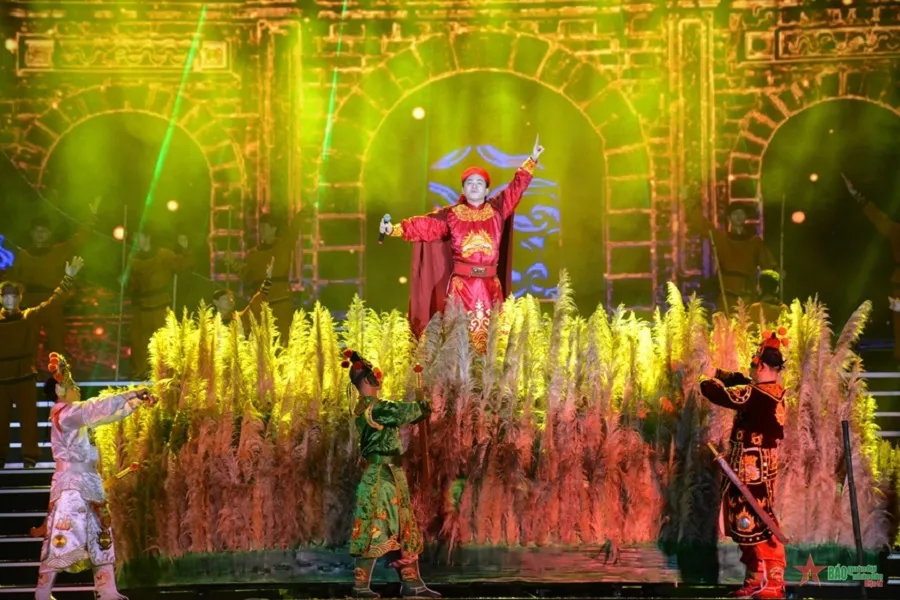
The "Cờ Lau Drill Performance" is not merely entertainment within the festival but also a piece that expresses admiration and respect for King Dinh Bo Linh's spirit of struggle and the determination of his forces, inspiring national pride and motivating the younger generation.
The "Writing Thai Binh Characters" performance at the Hoa Lu Festival is a poignant display meant to honor the reign title given by King Dinh Tien Hoang upon his accession to the throne and to recall the first Thai Binh currency in Vietnam. This act not only holds historical significance but also showcases the finesse of performance art.
Participating in this display are 120 young women dressed in traditional four-part dresses of blue, each holding a flag, moving rhythmically to the beat of the drum. They perform complex flag maneuvers to form each stroke of the characters. The first line forms the character "Thai" with special strokes, while the second line forms "Binh." When both lines lower their flags, the characters "Thai Binh" are clearly displayed, sending a message of peace and prosperity as desired by King Dinh Tien Hoang for the nation.
Furthermore, the Hoa Lu Festival includes a variety of supporting events that cater to both entertainment and educational purposes. Activities such as the Hoa Lu Beauty Contest, Cheo Singing Competition, Hoa Lu Volleyball Cup, exhibitions, and other contests not only enrich the festival's content but also help promote tourism, attract visitors, and enhance understanding of local culture and history.
The Hoa Lu Festival is more than just a cultural event of great significance to the people of Vietnam; it is a symbol of the cultural fusion and development over thousands of years of nation-building. Therefore, when exploring the natural and cultural heritage of the Trang An Scenic Complex, don't miss the opportunity to participate in this exciting festival.
Some attractive tourist destinations in Ninh Binh:
Copyright © 2022 BDATrip.com | All rights reserved.